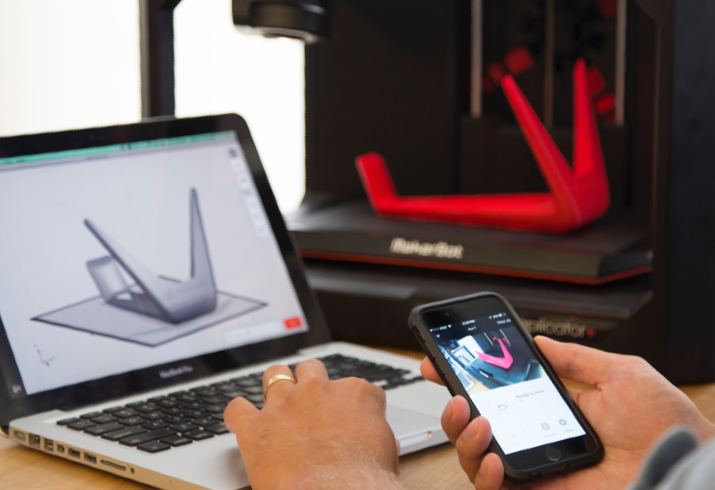Researchers from the University of Exeter and Durham University have warned of the “grave and growing threat” posed to individuals’ privacy by watermarked 3D printed products.
In their study, Dr Annika Jones and Dr James Griffin, experts in Intellectual Property (IP) and human rights law respectively, found that advances in 3D printing and Augmented Reality (AR) technology have created a new privacy threat. According to the researchers, fabricated objects may soon be embedded with symbols (or watermarks) that identify their makers, and could allow their owners to be traced using uploaded images.
Speaking to 3D Printing Industry Dr. Griffin said, “Watermarking isn’t widely used in 3D printing at the moment, but it is in other areas.”
“The problem is that the more we 3D print content, the more there is the possibility that everyday items might be used to track the movements of individuals. Something as basic as a 3D printed cup, or broach, could be tracked and traced in future through the uploading of photographs.”
3D Printing Industry also spoke to Sharon Flank, CEO of anti-counterfeiting firm InfraTrac, in order to better understand the research. For Flank, the safety concerns of fake products take precedence over any potential threats to personal privacy.
“Protecting our privacy is a major concern overall, but tracking 3D print design files is not where I would see the big dangers,” argued Flank. “Counterfeits cause crashes, fires, and injuries, and 3D printing can turn anyone into a credible manufacturer.”

What is watermarking and how is it dangerous?
Put simply, watermarks are essentially any mark or logo that can be used to identify the owner of any given content, and they have existed for decades. Anything from an ISBN number to a QR code can be found on everyday objects, but according to the researchers, the practice could spread to 3D printed objects as well.
“We found that you can actually put a watermark into an STL file, but it’s a bit tricky because the STL file itself is quite basic,” said Griffin. “There are other techniques as well. You can alter the surface of an object, put a texture on something that you print, or you can rotate small elements of it ever so slightly. These could be exploited by individuals, companies, and state entities. There are dangers at each level.”
For the researchers, 3D printing’s ability to interface with other technologies also makes its future threat to privacy more pronounced than it would otherwise be. As AR and Virtual Reality (VR) begin to become more mainstream in the coming years, the duo claim that they are likely to interface with 3D printed content and allow greater surveillance to take place.
“These technologies will be able to pick up on 3D printed watermarks,” explained Griffin. “So I could see a future where we’ve got the equivalent of a Google search for web pages and files, but for physical objects. It leads to a situation where you could really track people’s everyday lives to a very, very precise level.”
In order to validate their assumptions and further investigate the dangers of watermarking, the research duo interviewed a number of employees at Chinese 3D printing firms. Although several participants were adamant that they didn’t store customer files, they did reveal that significant personal data could be collected in the production of 3D printing materials.
In response to what they view as a growing threat, the research duo concluded that more needed to be done to future-proof legislation surrounding privacy, and prevent invasions of privacy before they occur. The team has now called for references to watermarking to be added to existing human rights legislation, as well as a voluntary code of conduct, and a regulatory body to enforce it.

Watermarking from a copyright perspective
Although Dr. Jones and Dr. Griffin make the case that watermarking is an imminent privacy threat, 3D printing companies could equally argue that it’s their right to protect their IP however they see fit. CAD files often contain patent or copyright-protected designs, and these can easily be downloaded and fabricated by those with 3D printing systems at home.
Consequently, watermarks represent one potential method whereby companies can protect any patents they hold over additive manufactured designs. According to Flank though, watermarks are an inefficient way for firms to safeguard their IP, and modern RFID tags would offer a far greater deal of protection.
“Printing a barcode onto a part in order to serialize it has a big flaw: 3D scanners will copy the barcode too,” explained Flank. “You could choose to serialize each 3D printed object with its own unique identifier, not in the software file but on the object. With an electronic tag, you could potentially find each one, and update the tag with information about usage.”
With regards to the broader debate about the privacy rights of individuals compared to those of companies seeking to preserve their IP, Flank actually identifies a further problem for both businesses and consumers. For Flank, the increasing accessibility of 3D scanning technologies creates the more imminent threat that hobbyists will reproduce structural end-use parts that don’t meet modern safety requirements.
“Given the capabilities of 3D scanners, it’s increasingly possible to create the design from an object,” added Flank. “When you think about how this could be done with aircraft parts or automobile brakes, putting fakes into the marketplace, you realize that copyrighted designs aren’t the biggest vulnerability we should be addressing.”
Taking the arguments of both the university academics and Flank into account, it appears that the researchers’ recommendations are unlikely to be adopted any time soon. The duo’s proposed threat to people’s privacy rights is simply too far away to be verified yet, and watermarks may have changed unrecognisably by the time it becomes a reality.
IP protection in the 3D printing industry
In some areas, 3D printing technology is advancing in leaps and bounds, but the debate surrounding intellectual property and 3D printing has surrounded the industry for a number of years.
In May 2020, the European Commission, the EU’s executive branch, released a study analyzing the state of 3D printing in relation to IP law. The team behind the research identified many potential challenges, but also suggested future steps to make the European 3D printing industry more competitive.
The UK Intellectual Property Office (IPO) has developed an ongoing body of research into “3D printing and intellectual property futures,” known as the ‘3DPIP Futures’ project. As of January 2019, the study’s authors found no pressing need for legal reform, although they did feel that some clarification of existing IP laws and 3D printing was required.
In a guest article writing for 3D Printing Industry, Jason Teng of IP law firm, Potter Clarkson explained some of the complexities surrounding 3D printing in copyright law. Teng highlighted that confusion over replacement parts, jurisdictions, and case law could lead to further legislation to protect IP in future.
The researchers’ findings are detailed in their paper titled “3D Printing and the Right to Privacy: Proposals for a Regulatory Framework,” which was published in the European Journal for Law and Technology, and co-authored by Dr Annika Jones and Dr James Griffin.
Nominations for the 2020 3D Printing Industry Awards are still open, let us know who is leading the industry now.
The fourth edition of the 3D Printing Industry Awards Trophy Design Competition is now underway. Enter your design for the chance to win a CraftBot Flow 3D printer.
To stay up to date with the latest 3D printing news, don’t forget to subscribe to the 3D Printing Industry newsletter or follow us on Twitter or liking our page on Facebook.
Are you looking for a job in the additive manufacturing industry? Visit 3D Printing Jobs for a selection of roles in the industry.
Featured image shows 3D design software being used simultaneously across a laptop and mobile device. Photo via Makerbot.



